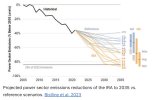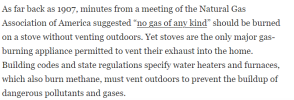You are using an out of date browser. It may not display this or other websites correctly.
You should upgrade or use an alternative browser.
You should upgrade or use an alternative browser.
Climate and Weather
- Thread starter espola
- Start date

Lyten Achieves Manufacturing Milestone; Now Producing Lithium-Sulfur Batteries At Greater Than 90% Yield
Lyten, a supermaterials application company and the leader in lithium-sulfur battery technology, today announced it is consistently surpassing 90 perc
www.businesswire.com
kickingandscreaming
PREMIER
For those interested in climate science instead of climate advocacy, this guy is excellent. Here's one of his posts.
Low Hanging Fruit
How to Eliminate 25% of Global Carbon Dioxide Emissions by 2035
ROGER PIELKE JR
Climate policy focused on reducing emissions often looks like a Rube Goldberg device, with complexity built upon complexity such that policy levers may or may not impact the intended outcome — which is reducing the emissions of carbon dioxide from fossil fuels all the way to net-zero.
Today I share a simple proposal that would reduce global carbon dioxide emissions from the burning of fossil fuels by 25% by 2035, and at a cost far less than the emissions reductions expected under the Biden Administration’s Inflation Reduction Act (IRA). My analysis below is in round numbers, and please feel free in the comments to challenge my work and offer your own math for emissions or economics.
In a 2021 paper, Grant et al. concluded that just 5% of the world’s coal power plants were responsible for about 73% of carbon dioxide emissions from global electricity generation. With about 3,000 coal power plants globally in their analysis,¹ that equates to about 150 power plants being responsible for ~25% of total global emissions from the burning of fossil fuels (assuming electricity makes up ~35% of global total emissions).
Top 10 emitting coal plants in 2018. Source: Grant et al. 2021.
If the world committed to replacing those 150 coal plants with nuclear power plants by 2035 — perhaps negotiated under the provisions of the Paris Agreement — that would reduce total global emissions by ~25%, or almost 9 gigatonnes carbon dioxide (GtCO2), from the 2022 level of >34.3 GtCO2. That’s huge.
How much would the replacement generation cost?
Let’s look to China where new nuclear power plants are asserted to cost ~$3 billion and can be brought online in 10 years. But just to be safe, let’s include some higher cost values, say $10 billion and $20 billion per new plant, with no assumptions of learning curves or economies of scale.²
For 150 plants, that leads to cost estimates of $450 billion, $1.5 trillion and $3 trillion, cumulatively to 2035.
How do those estimates compare to the recently implemented and widely celebrated U.S. Inflation Reduction Act (IRA)?
Projected power sector emissions reductions of the IRA to 2035 vs. reference scenarios. Bistline et al. 2023
According to a 2023 paper in Science, the IRA is projected to result in a reduction of between zero and ~2.8 GtCO2 in U.S. power sector emissions, as shown in the figure above.³
How much would that cost? According to the Brookings Institution (involving a similar authorship to the paper cited above), the IRA could cost about $1 trillion to 2035, and you can also find lower or higher estimates.
Let’s put all this together:
The best case IRA scenario provides emissions reductions of ~2.8 GtCO2 for ~$1 trillion.
The best case coal-to-nuclear scenario provides ~9 GtCO2 for ~$450 billion.
Coal-to-nuclear is more cost effective by about about 7 to 1.
The worst case IRA scenario provides no emissions reductions for ~$1 trillion.
The worst case coal-to-nuclear scenario provides emissions reductions of ~9 GtCO2 for ~$3 trillion.
Here, coal-to-nuclear is infinitely more cost effective. That’s a big number.
These numbers are conservative — you can vary the assumptions a great deal and these conclusions will still hold firm.
Of course, some countries are profoundly anti-nuclear. Fair enough — then keep going down the list of the most emissions-intensive coal plants and select those in nuclear-friendly countries. In the table up post, there is only one country that hosts one of the top-10 most polluting coal plants that is opposed to nuclear, Germany, the others are all nuclear friendly.
The simple and blindingly obvious reality is that if the world is going to reach net-zero carbon dioxide emissions, then all coal plants will have to be either retired or retro-fitted with carbon capture and storage technologies, which do not yet exist at scale. Nuclear power does actually exist.
Sometimes the most direct route between two points is a straight line. Why not start with the low-hanging fruit?
1 The actual number in the Grant et al. analysis is less, they explain: “After data preparation and outlier removal, there are 3,019 plant-level observations with observable annual capacity factor and 2,581 with observable CO2 emission factor.” Using 3,000 makes my analysis that much more conservative.
2 More generally, a coal-to-nuclear replace program of this type could spur a global innovation race that seeks to improve the economics, performance and safety of nuclear technologies.
3 This range is computed based on the smallest and largest differences between baselines and IRA scenarios. That may or may not be methodologically correct, as baseline and IRA scenarios may be tied together, but it does err the analysis in favor of being overly generous to the projected effects of the IRA.
Low Hanging Fruit
How to Eliminate 25% of Global Carbon Dioxide Emissions by 2035
ROGER PIELKE JR
Climate policy focused on reducing emissions often looks like a Rube Goldberg device, with complexity built upon complexity such that policy levers may or may not impact the intended outcome — which is reducing the emissions of carbon dioxide from fossil fuels all the way to net-zero.
Today I share a simple proposal that would reduce global carbon dioxide emissions from the burning of fossil fuels by 25% by 2035, and at a cost far less than the emissions reductions expected under the Biden Administration’s Inflation Reduction Act (IRA). My analysis below is in round numbers, and please feel free in the comments to challenge my work and offer your own math for emissions or economics.
In a 2021 paper, Grant et al. concluded that just 5% of the world’s coal power plants were responsible for about 73% of carbon dioxide emissions from global electricity generation. With about 3,000 coal power plants globally in their analysis,¹ that equates to about 150 power plants being responsible for ~25% of total global emissions from the burning of fossil fuels (assuming electricity makes up ~35% of global total emissions).
Top 10 emitting coal plants in 2018. Source: Grant et al. 2021.
If the world committed to replacing those 150 coal plants with nuclear power plants by 2035 — perhaps negotiated under the provisions of the Paris Agreement — that would reduce total global emissions by ~25%, or almost 9 gigatonnes carbon dioxide (GtCO2), from the 2022 level of >34.3 GtCO2. That’s huge.
How much would the replacement generation cost?
Let’s look to China where new nuclear power plants are asserted to cost ~$3 billion and can be brought online in 10 years. But just to be safe, let’s include some higher cost values, say $10 billion and $20 billion per new plant, with no assumptions of learning curves or economies of scale.²
For 150 plants, that leads to cost estimates of $450 billion, $1.5 trillion and $3 trillion, cumulatively to 2035.
How do those estimates compare to the recently implemented and widely celebrated U.S. Inflation Reduction Act (IRA)?
Projected power sector emissions reductions of the IRA to 2035 vs. reference scenarios. Bistline et al. 2023
According to a 2023 paper in Science, the IRA is projected to result in a reduction of between zero and ~2.8 GtCO2 in U.S. power sector emissions, as shown in the figure above.³
How much would that cost? According to the Brookings Institution (involving a similar authorship to the paper cited above), the IRA could cost about $1 trillion to 2035, and you can also find lower or higher estimates.
Let’s put all this together:
The best case IRA scenario provides emissions reductions of ~2.8 GtCO2 for ~$1 trillion.
The best case coal-to-nuclear scenario provides ~9 GtCO2 for ~$450 billion.
Coal-to-nuclear is more cost effective by about about 7 to 1.
The worst case IRA scenario provides no emissions reductions for ~$1 trillion.
The worst case coal-to-nuclear scenario provides emissions reductions of ~9 GtCO2 for ~$3 trillion.
Here, coal-to-nuclear is infinitely more cost effective. That’s a big number.
These numbers are conservative — you can vary the assumptions a great deal and these conclusions will still hold firm.
Of course, some countries are profoundly anti-nuclear. Fair enough — then keep going down the list of the most emissions-intensive coal plants and select those in nuclear-friendly countries. In the table up post, there is only one country that hosts one of the top-10 most polluting coal plants that is opposed to nuclear, Germany, the others are all nuclear friendly.
The simple and blindingly obvious reality is that if the world is going to reach net-zero carbon dioxide emissions, then all coal plants will have to be either retired or retro-fitted with carbon capture and storage technologies, which do not yet exist at scale. Nuclear power does actually exist.
Sometimes the most direct route between two points is a straight line. Why not start with the low-hanging fruit?
1 The actual number in the Grant et al. analysis is less, they explain: “After data preparation and outlier removal, there are 3,019 plant-level observations with observable annual capacity factor and 2,581 with observable CO2 emission factor.” Using 3,000 makes my analysis that much more conservative.
2 More generally, a coal-to-nuclear replace program of this type could spur a global innovation race that seeks to improve the economics, performance and safety of nuclear technologies.
3 This range is computed based on the smallest and largest differences between baselines and IRA scenarios. That may or may not be methodologically correct, as baseline and IRA scenarios may be tied together, but it does err the analysis in favor of being overly generous to the projected effects of the IRA.
kickingandscreaming
PREMIER
Associated DiagramsFor those interested in climate science instead of climate advocacy, this guy is excellent. Here's one of his posts.
Low Hanging Fruit
How to Eliminate 25% of Global Carbon Dioxide Emissions by 2035
ROGER PIELKE JR
Climate policy focused on reducing emissions often looks like a Rube Goldberg device, with complexity built upon complexity such that policy levers may or may not impact the intended outcome — which is reducing the emissions of carbon dioxide from fossil fuels all the way to net-zero.
Today I share a simple proposal that would reduce global carbon dioxide emissions from the burning of fossil fuels by 25% by 2035, and at a cost far less than the emissions reductions expected under the Biden Administration’s Inflation Reduction Act (IRA). My analysis below is in round numbers, and please feel free in the comments to challenge my work and offer your own math for emissions or economics.
In a 2021 paper, Grant et al. concluded that just 5% of the world’s coal power plants were responsible for about 73% of carbon dioxide emissions from global electricity generation. With about 3,000 coal power plants globally in their analysis,¹ that equates to about 150 power plants being responsible for ~25% of total global emissions from the burning of fossil fuels (assuming electricity makes up ~35% of global total emissions).
Top 10 emitting coal plants in 2018. Source: Grant et al. 2021.
If the world committed to replacing those 150 coal plants with nuclear power plants by 2035 — perhaps negotiated under the provisions of the Paris Agreement — that would reduce total global emissions by ~25%, or almost 9 gigatonnes carbon dioxide (GtCO2), from the 2022 level of >34.3 GtCO2. That’s huge.
How much would the replacement generation cost?
Let’s look to China where new nuclear power plants are asserted to cost ~$3 billion and can be brought online in 10 years. But just to be safe, let’s include some higher cost values, say $10 billion and $20 billion per new plant, with no assumptions of learning curves or economies of scale.²
For 150 plants, that leads to cost estimates of $450 billion, $1.5 trillion and $3 trillion, cumulatively to 2035.
How do those estimates compare to the recently implemented and widely celebrated U.S. Inflation Reduction Act (IRA)?
Projected power sector emissions reductions of the IRA to 2035 vs. reference scenarios. Bistline et al. 2023
According to a 2023 paper in Science, the IRA is projected to result in a reduction of between zero and ~2.8 GtCO2 in U.S. power sector emissions, as shown in the figure above.³
How much would that cost? According to the Brookings Institution (involving a similar authorship to the paper cited above), the IRA could cost about $1 trillion to 2035, and you can also find lower or higher estimates.
Let’s put all this together:
The best case IRA scenario provides emissions reductions of ~2.8 GtCO2 for ~$1 trillion.
The best case coal-to-nuclear scenario provides ~9 GtCO2 for ~$450 billion.
Coal-to-nuclear is more cost effective by about about 7 to 1.
The worst case IRA scenario provides no emissions reductions for ~$1 trillion.
The worst case coal-to-nuclear scenario provides emissions reductions of ~9 GtCO2 for ~$3 trillion.
Here, coal-to-nuclear is infinitely more cost effective. That’s a big number.
These numbers are conservative — you can vary the assumptions a great deal and these conclusions will still hold firm.
Of course, some countries are profoundly anti-nuclear. Fair enough — then keep going down the list of the most emissions-intensive coal plants and select those in nuclear-friendly countries. In the table up post, there is only one country that hosts one of the top-10 most polluting coal plants that is opposed to nuclear, Germany, the others are all nuclear friendly.
The simple and blindingly obvious reality is that if the world is going to reach net-zero carbon dioxide emissions, then all coal plants will have to be either retired or retro-fitted with carbon capture and storage technologies, which do not yet exist at scale. Nuclear power does actually exist.
Sometimes the most direct route between two points is a straight line. Why not start with the low-hanging fruit?
1 The actual number in the Grant et al. analysis is less, they explain: “After data preparation and outlier removal, there are 3,019 plant-level observations with observable annual capacity factor and 2,581 with observable CO2 emission factor.” Using 3,000 makes my analysis that much more conservative.
2 More generally, a coal-to-nuclear replace program of this type could spur a global innovation race that seeks to improve the economics, performance and safety of nuclear technologies.
3 This range is computed based on the smallest and largest differences between baselines and IRA scenarios. That may or may not be methodologically correct, as baseline and IRA scenarios may be tied together, but it does err the analysis in favor of being overly generous to the projected effects of the IRA.


kickingandscreaming
PREMIER
It’s not a crisis. Well, at least not a climate crisis. I can’t speak to the mental crisis of those who believe we are in a climate crisis. As I have mentioned before, I would like to invest in it. I’m thinking drug companies. If there’s one thing old school liberals and the current leftist authoritarians have in common, it’s a propensity to medicate. Enjoy some sanity below, if that sort of thing doesn’t trigger you.
Earth Day Optimism
You are invited to two panels today on climate and environmental policy
ROGER PIELKE JR.
APR 22
Yesterday, I was surprised to see the New York Times publish an essay with the title, Climate Doom Is Out. ‘Apocalyptic Optimism’ Is In. The framing of the article was about political expediency — is optimism a more effective political framing than pessimism when trying to motivate people to do this or that? My answer to that question is the answer will depend if the action is sheltering from a tornado bearing down or changing the global energy system.
What the essay did not address is whether or not there is an empirical and scientific basis for an outlook on the environment that is more hopeful than the steady stream of apocalypse porn typically emphasized. As readers of THB well know, the answer is a resounding “Yes.”
Environmental optimism is not the same thing as Panglossian ignorance, and often, optimism/pessimism says a lot more about an individual than it does the planet. Even so, there are objective reasons for optimism, for those choosing so.
A few years ago, I imagined how we might be received by the authors of the Intergovernmental Panel on Climate Change (IPCC) decades ago if we got into a time machine and told them about the state of climate science understandings today:
Us: Hello IPCC, we are from the future!
IPCC: You aren’t Terminators are you?
Us: No, but we do come with knowledge from 2024 about which of your 1,311 scenarios are still judged to be plausible in 2024, and which ones can be judged to be implausible representations of the rest of the 21st century.
IPCC: Oh my! That is fantastic news. As you know, the mandate of the IPCC is to use only plausible scenarios, so if we can identify those which are implausible, that would make our work much more relevant to policymakers, which after all is our mission.
Us: Here is what we found: Using our more restrictive criterion, we have identified 71 of your 1,311 scenarios that reman plausible based only on what actually happened 2005 to 2020 and that number is cut in half, to 35, when we also consider the 2020 IEA projections to 2050.
IPCC: Wow. That is a lot of scenarios that hit the cutting room floor.
Us: Right. As we explain, “as the future unfolds, we should fully expect that the subset of available scenarios judged to be plausible shrinks in number over time as reality constrains possibilities as the future becomes the present.”
IPCC: So now I am nervous. In our full set of 1,311 scenarios there are some truly apocalyptic futures. I mean, the scenario that is identified as “business as usual” and is most commonly used in climate research projects that the world will build something like 33,000 new coal power plants by 2100 and global temperatures might increase by 5 degrees Celsius or more. I’d expect that in 2024 that remains our best guess for the future, right?
Us: Actually, no. We have some very good news for you. Very good news.
IPCC: Tell me! We need some good news on climate.
Us: In a nutshell, all of the plausible scenarios remaining from the ones you are working with today envision less than 3 degrees Celsius total warming by 2100. In fact, the median projection is for 2100 warming from the subset of plausible scenarios of 2.2 degrees Celsius, which is within spitting distance of the Paris Agreement goal of holding temperatures to a warming of 2.0 degrees Celsius.
IPCC: What is the Paris Agreement?
Us: Don’t worry, you’ll find out.
IPCC: I find that both incredibly reassuring and incredibly hard to believe. How did our expectations of the future change so fast?
Us: Long story. But in short, the scenarios you have been using include some pretty dubious assumptions about future energy production. And the world over the next decade will actually start
moving on decarbonization. Things really do look a lot different in 2024.
IPCC: That is incredibly good news!
Us: Yes indeed, it is. Of course the challenge of deep decarbonization remains as dauting as ever in 2024, but the extreme scenarios that you have been focusing on appear to be off the table. Hey, I need to get back to the future, as I have two panels to participate in at AEI on Earth Day 2024.
IPCC: Wait! You’re at AEI in 2024?
Us: Damn straight. Academia is a mess and I’m thrilled to be at one of the country’s leading think tanks. In the future, subscribe to The Honest Broker on Substack to learn more . . .
IPCC: Substack?!
Earth Day Optimism
You are invited to two panels today on climate and environmental policy
ROGER PIELKE JR.
APR 22
Yesterday, I was surprised to see the New York Times publish an essay with the title, Climate Doom Is Out. ‘Apocalyptic Optimism’ Is In. The framing of the article was about political expediency — is optimism a more effective political framing than pessimism when trying to motivate people to do this or that? My answer to that question is the answer will depend if the action is sheltering from a tornado bearing down or changing the global energy system.
What the essay did not address is whether or not there is an empirical and scientific basis for an outlook on the environment that is more hopeful than the steady stream of apocalypse porn typically emphasized. As readers of THB well know, the answer is a resounding “Yes.”
Environmental optimism is not the same thing as Panglossian ignorance, and often, optimism/pessimism says a lot more about an individual than it does the planet. Even so, there are objective reasons for optimism, for those choosing so.
A few years ago, I imagined how we might be received by the authors of the Intergovernmental Panel on Climate Change (IPCC) decades ago if we got into a time machine and told them about the state of climate science understandings today:
Us: Hello IPCC, we are from the future!
IPCC: You aren’t Terminators are you?
Us: No, but we do come with knowledge from 2024 about which of your 1,311 scenarios are still judged to be plausible in 2024, and which ones can be judged to be implausible representations of the rest of the 21st century.
IPCC: Oh my! That is fantastic news. As you know, the mandate of the IPCC is to use only plausible scenarios, so if we can identify those which are implausible, that would make our work much more relevant to policymakers, which after all is our mission.
Us: Here is what we found: Using our more restrictive criterion, we have identified 71 of your 1,311 scenarios that reman plausible based only on what actually happened 2005 to 2020 and that number is cut in half, to 35, when we also consider the 2020 IEA projections to 2050.
IPCC: Wow. That is a lot of scenarios that hit the cutting room floor.
Us: Right. As we explain, “as the future unfolds, we should fully expect that the subset of available scenarios judged to be plausible shrinks in number over time as reality constrains possibilities as the future becomes the present.”
IPCC: So now I am nervous. In our full set of 1,311 scenarios there are some truly apocalyptic futures. I mean, the scenario that is identified as “business as usual” and is most commonly used in climate research projects that the world will build something like 33,000 new coal power plants by 2100 and global temperatures might increase by 5 degrees Celsius or more. I’d expect that in 2024 that remains our best guess for the future, right?
Us: Actually, no. We have some very good news for you. Very good news.
IPCC: Tell me! We need some good news on climate.
Us: In a nutshell, all of the plausible scenarios remaining from the ones you are working with today envision less than 3 degrees Celsius total warming by 2100. In fact, the median projection is for 2100 warming from the subset of plausible scenarios of 2.2 degrees Celsius, which is within spitting distance of the Paris Agreement goal of holding temperatures to a warming of 2.0 degrees Celsius.
IPCC: What is the Paris Agreement?
Us: Don’t worry, you’ll find out.
IPCC: I find that both incredibly reassuring and incredibly hard to believe. How did our expectations of the future change so fast?
Us: Long story. But in short, the scenarios you have been using include some pretty dubious assumptions about future energy production. And the world over the next decade will actually start
moving on decarbonization. Things really do look a lot different in 2024.
IPCC: That is incredibly good news!
Us: Yes indeed, it is. Of course the challenge of deep decarbonization remains as dauting as ever in 2024, but the extreme scenarios that you have been focusing on appear to be off the table. Hey, I need to get back to the future, as I have two panels to participate in at AEI on Earth Day 2024.
IPCC: Wait! You’re at AEI in 2024?
Us: Damn straight. Academia is a mess and I’m thrilled to be at one of the country’s leading think tanks. In the future, subscribe to The Honest Broker on Substack to learn more . . .
IPCC: Substack?!






